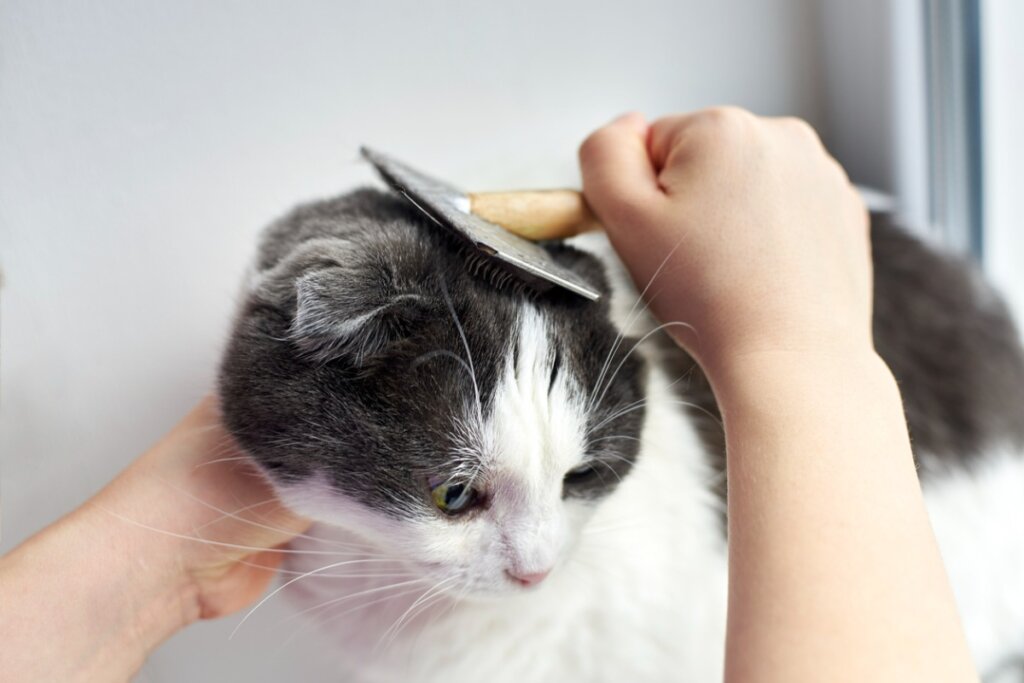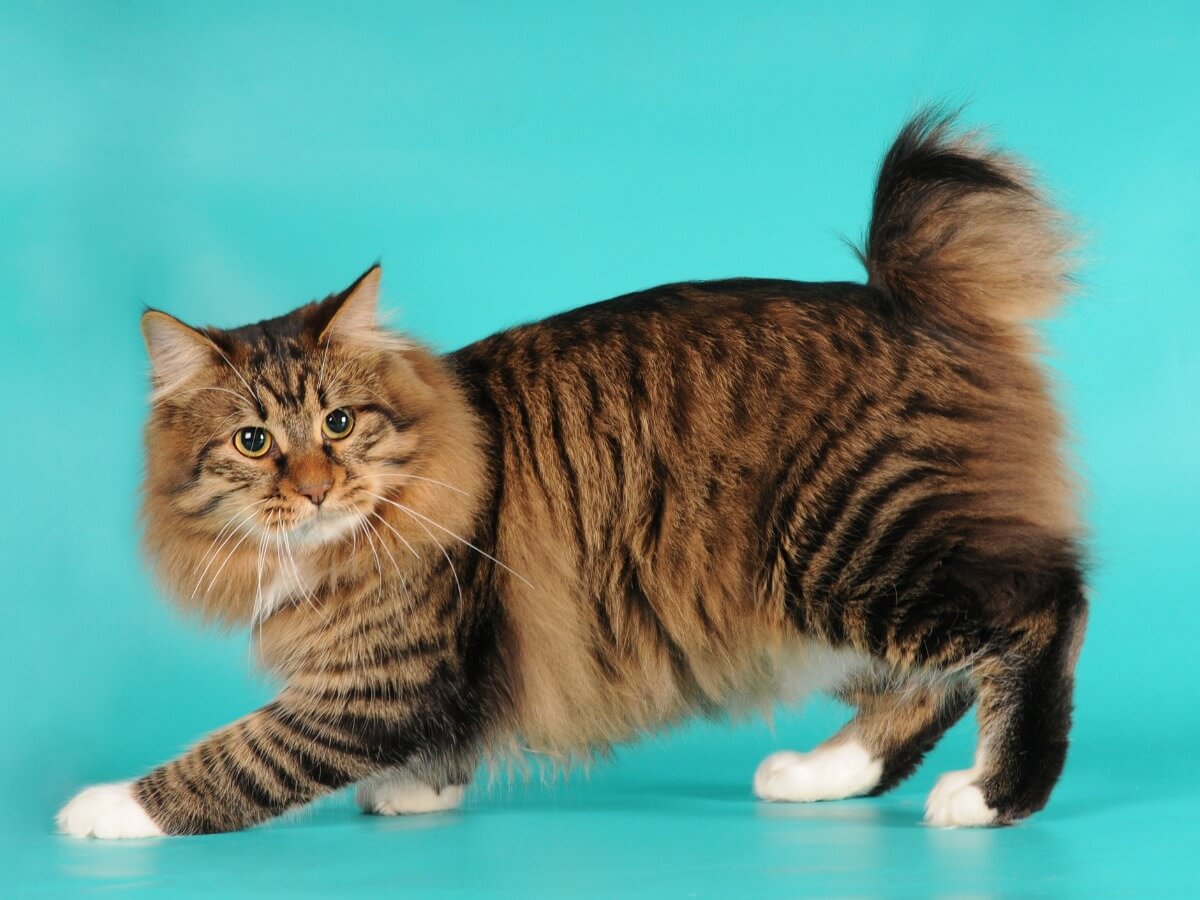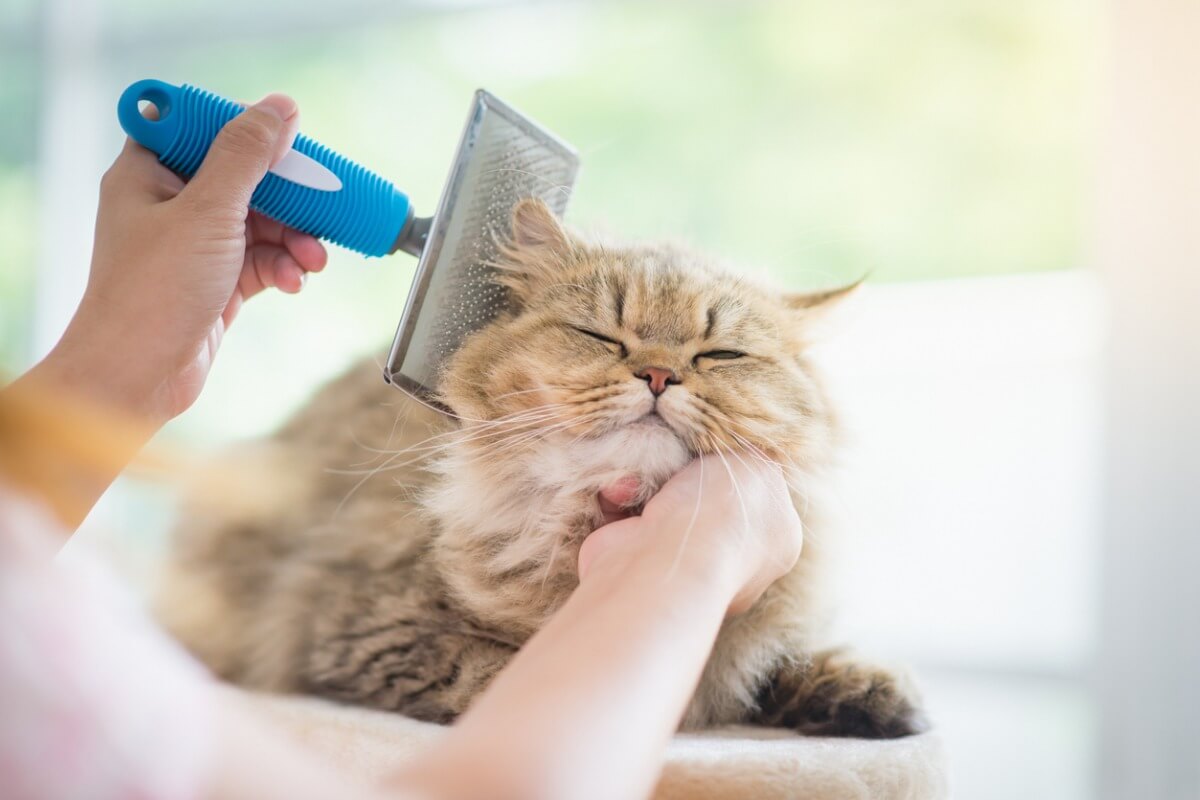Cat Hair Loss: How Can I Prevent It?

Cat hair loss is normal during natural shedding periods. However, if this happens outside these periods, it may not be a good sign, especially if the animal begins to suffer alopecia in certain areas.
The reasons why a feline loses hair are many and all should be treated by a veterinarian. In addition, cat owners can follow some tips to prevent their cat’s fur from falling out. Here’s everything you need to know about this topic!
Common causes of cat hair loss
The deep root of the problem of cat hair loss is usually explained by 2 main reasons: physical causes and psychological reasons. To determine the specific cause, at the slightest detection of abnormal hair loss, you should go to a veterinarian.
Among the physical causes are certain diseases, as well as the direct action of external parasites. As for psychological reasons, stress or anxiety can be the cause of hair loss in cats.
Depending on the severity of the condition, you can see alopecic areas anywhere on the cat’s fur, to a greater or lesser extent. In addition, wounds, hyperpigmentation, and other skin damage often appear along with the hair loss.
Genetic predispositions
Before going on to clarify in more detail the common causes of hair loss in felines, it should be emphasized that there’s some genetic predisposition to hair loss in some of them. For example, some of the cats that tend to lose more hair are the American curl, the Russian blue cat, the American bobtail, the Nebelung cat, and the Chartreux.

When should you worry about cat hair loss?
Cats shed hair throughout the year, but moderately. However, at times when the temperature change is more pronounced, as it usually is between the transition from winter to spring or during the fall, the hair loss is more evident.
Outside these specific times, if the cat hair loss occurs abundantly, you should take note and consult with a professional. It’s essential that they diagnose correctly, because there are some contagious causes of feline alopecia. Let’s see the most common reasons that cause cat hair loss.
Malassezia dermatitis
Malassezia is a genus of fungi that naturally inhabits the skin of animals and mucous membranes. When, for some reason, there’s an imbalance in the cat’s dermis, this pathogen can proliferate, especially in areas of the body where folds are formed.
To confirm that the problem is caused by this fungus, a skin sample should be taken and analyzed under a microscope. If the number of units of the microorganism is high, the diagnosis is confirmed. Usually, the treatment consists of the application of ointments, baths with special shampoos, or some antifungals administered orally.
When Malassezia proliferates in a cat’s skin, it will cause intense itching, as well as causing lesions that will vary in severity depending on the case. These can result in scaling, alopecia, and reddened areas. In addition, the skin usually gives off a bad smell, darkens, and thickens if not treated.
Feline psychogenic alopecia
The root cause of feline psychogenic alopecia is anxiety or stress. These problems can cause the cat to tear out its own hair due to excessive stereotypic licking or excessive grooming. The hair loss will occur in these cases in areas where the feline reaches with his mouth and we can usually see them on the sides, perineal region, and hind limbs.
If the cat continues to lick the area, irritations may appear. In addition, removing hair from these areas means it’s likely to create wounds or other injuries.
In this case, what you should do is to identify the causes of feline stress or anxiety to be able to modify the situation. Sometimes, the veterinarian recommends some type of calming treatment.
Tinea or dermatophytosis
Another cause of hair loss in cats is ringworm. This is a very contagious disease, caused by fungi that live in the cells of the outer layer of the skin.
The pathology can occur in sick cats with weak or underdeveloped immune systems, in young cats, or in poorly nourished adults. The severity of symptoms is highly variable, depending on the characteristics of the animal and the fungus.
For example, some cats have no symptoms, while others do. In those that do show clinical signs, swollen areas, lesions, desquamation, rounded or irregular alopecic areas, itching, and granulomas can be observed. To diagnose the condition, the veterinarian should perform a culture and analyze it. Depending on the severity, it can be treated with topical or oral antifungals.
Notoedric mange
To diagnose any type of mange, a microscopic observation of the causative mite, in this case, Notoedres cati, must be performed. It’s important to detect it early, as it can be transmitted to people, albeit in a mild way.
The cat affected by this mite will have lesions on the skin, loss of hair in certain areas, thickened skin, and scabs, usually on the head. It can also occur in the perineal area and front paws and the treatment usually opts for the use of acaricides.
Telogen effluvium
This is another cause of hair loss in cats related to psychological problems, such as anxiety. When the stressful situation for the animal prolongs over time, or is very intense, then it can cause the normal hair cycle to be interrupted.
Once the cat recovers a calm state of mind, this cycle restarts, eliminating the old hair and replacing it with new hair. This usually happens between 1 and 3 months after the stressful event.
If there are no skin symptoms, the cause is usually ruled out by examining the animal’s medical history. It isn’t necessary to prescribe any treatment beyond brushing the cat’s coat to encourage the new coat to grow healthier.
Flea allergy dermatitis (FAD)
This disease is caused by a reaction to flea saliva and is common in cats aged 3 to 6 years. It’s quite common in the summer season, as this is when these parasites proliferate.
Signs are usually evident at the end of the animal’s back, neck, abdomen, and sides, and they can extend to the perineum. In addition to the pruritus (itching), the cat can damage the skin by scratching intensely. This will cause wounds, alopecia, epidermal thickening, and the other signs already mentioned.
Feline atopy
Feline atopy is another cause of hair loss in cats, usually in those under 3 years old, and is caused by contact with dust, pollen, mold, and other allergens. Itching is the main symptom, although alopecia can also occur.
In addition to these symptoms, the cat may have coughing, conjunctivitis, sneezing, and make noises when breathing. To determine that it is this disease, the veterinarian must perform the relevant tests and exclude other pathologies. The treatment usually consists of medication to control itching, corticosteroids, or immunomodulators that work on the immune system.
How to prevent hair loss in cats?
As we have seen, the causes that can lead to hair loss in cats are quite diverse. Depending on what triggers it, the veterinarian should establish treatment to enable the cat to recover. However, there are some general tips that cat owners should follow in order to prevent some of the reasons for hair loss.
Environmental enrichment
Offering the cat an enriched environment is to provide everything necessary to develop their feline nature: toys for hunting, places to hide, places to climb and stalk, methods of exercise, games, etc. Overriding their instinct can cause stress and anxiety.
Deworming
Deworming should be carried out on a regular and controlled basis in order to keep fleas, ticks and other parasites away from the feline. Complying with this is as important as the vaccination schedule.
A safe environment
In addition to environmental enrichment, the cat must live in a quiet place that gives them a sense of security. If this isn’t the case, emotional problems can also appear and cause hair loss.
Quality food
The animal’s diet should be balanced and of good quality. A poor diet can cause many health problems in the animal, including weakness and hair loss.
Early treatment
Frequent check-ups to detect diseases in the cat’s skin will help the early identification of any problems that may trigger alopecia. If this happens, you should consult a veterinarian.
Brushing the hair
Brushing the cat’s hair will promote their capillary health, as well as helping to detect these potential skin problems more easily. Accustoming the cat to brushing from when they’re a kitten is essential in order to make this task easier. Besides this, it’s a great opportunity to establish bonds of affection between guardian and cat.

There are many reasons why your cat may suffer from hair loss or alopecia. Many conditions can be dealt with at home, but others require urgent veterinary attention. If in doubt, consult a professional.
All cited sources were thoroughly reviewed by our team to ensure their quality, reliability, currency, and validity. The bibliography of this article was considered reliable and of academic or scientific accuracy.
- Alopecia. Recogido el 31 de agosto en http://vetfolio-vetstreet.s3.amazonaws.com/72/d52280a22011e2896d005056ad4735/file/Gu%C3%ADaDeCuidado_Alopecia.pdf
- Dermatosis felinas en colectividades. Recogido el 31 de agosto en http://www.colvema.org/pdf/dermatosisfelinas.pdf
- Enfermedades de la piel en perro y gato. Recogido el 31 de agosto en http://www.rednacionaldeveterinarias.com.uy/articulos/dermatologia/Veterinaria_Enfermedades_De_La_Piel_En_Perro_Y_Gato.pdf
- Why is My Cat Losing Hair? Hair Loss in Cats. Recogido el 31 de agosto en https://www.petmd.com/cat/conditions/skin/c_ct_alopecia#:~:text=Keep%20your%20cat%20on%20effective,of%20hair%20loss%20in%20cats.
- Cat Hair Loss: Causes and Treatment. Recogido el 31 de agosto en https://resources.bestfriends.org/article/cat-hair-loss-causes-and-treatment
